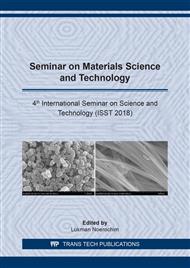p.228
p.234
p.240
p.246
p.251
p.257
p.263
p.270
p.280
Analysis the Effect of Temperature and Holding Time of Full - Annealing Heat Treatment to Micro Structure, Mechanical Properties, and Electrical Conductivity of Aluminium Copper (Al-Cu) Alloy
Abstract:
Good electrical conductivity properties of aluminium are the main reason this metal become an option as material of electrical devices. To improve the ductility and electrical conductivity properties, aluminium is combined with copper. The aim of this study is to analyze the effect of temperature and holding time of full-annealing heat treatment to the micro structure, hardness, and electrical conductivity of aluminium copper alloy (Al-Cu). In this research, pure aluminium with the addition of 4% copper (Cu) composition has been casted with gravity die casting mold made from ductile cast iron, and continued full-annealing heat treatment with 3 variations at temperature (2600C, 3500C, and 4400C), and 3 variations of holding time (2 hours, 3 hours, and 4 hours). It was found that the effect of higher temperature at the same holding time with the full-annealing heat treatment caused the grains of phase α become more regular and greater so that the hardness decreased and the electrical conductivity was increased.
Info:
Periodical:
Pages:
280-285
Citation:
Online since:
July 2019
Authors:
Price:
Сopyright:
© 2019 Trans Tech Publications Ltd. All Rights Reserved
Share:
Citation:


